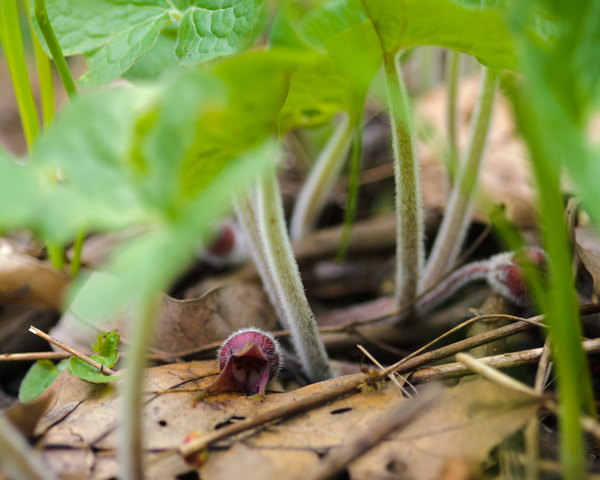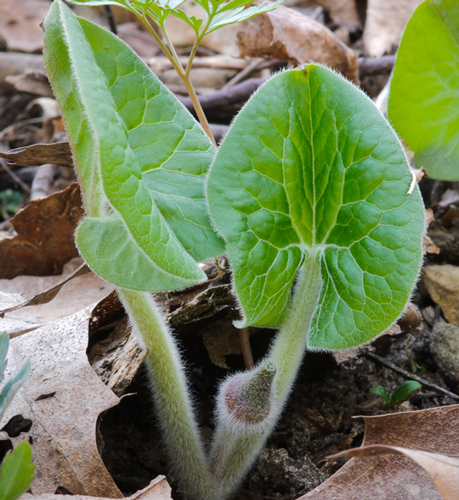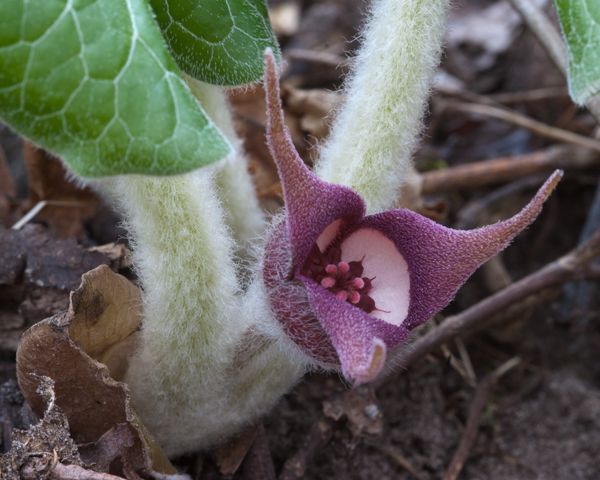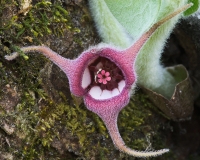
Taken by the author in Riverside Park, Milwaukee, WI
This common wildflower of eastern North America, which you can find growing plentifully in Riverside Park, is easy to overlook.
Wild ginger has heart-shaped leaves about the size of your palm, which grow to almost a foot in height. Each plant produces two leaves which when young can be mistaken for similar but much smaller violet leaves.
To find the flower of wild ginger, you need to get down on your knees and start looking under the plant’s heart-shaped leaves. There you’ll see a hairy, three-pointed cup roughly an inch wide. Sometimes the cup grows basically into the soil, so you might have to scratch around to find it.
The flower’s shape gives wild ginger another of its common names: little jug. The jug is purple or maroon and tan, though it can be quite green when it’s young. It’s often mottled or splotchy. It’s composed of three fused sepals, not petals. Yep, it’s a flower without petals. The sepals taper to points, which gives the flower something of a jester’s-hat look about it.
The sepals are covered in tiny grey hairs, as are the stems of the leaves and the leaves themselves when young. You can see in this picture just how hairy wild ginger can be.

Taken by the author in Ferry Bluff State Natural Area near Sauk City, WI
Each plant produces only a single flower, which grows underneath its leaves. Why does the plant hide its flower? There are some intriguing theories.
In the spring, flies emerge from the soil and begin hunting for food. By having flowers ready and waiting on the ground, wild ginger could be attracting these emerging flies. The fleshy color of the flower might also attract them, as some of these flies feed on carcasses. In other words, wild ginger could be using its strange flowers to fool flies. The flies, in return, feed upon the plant’s pollen, and help distribute it to other plants.
The broad leaves might also play a role in pollination. Insects hide underneath the densely growing wild ginger leaves, and even in the little jugs, as shelter from the early spring weather. Could wild ginger be protecting insects to increase its own chances of pollination? Many botanists think so!
But the fascinating relationships between wild ginger and insects doesn’t end there.
After the flower has been pollinated, it turns into a pod. Here again, we find a reason for where the flower blooms. A wild ginger seed has a fleshy growth on it called an elaiosome (“oil-body”). Elaiosomes don’t directly provide nourishment to the sprout held within the seed.
Why would a plant seed have an elaiosome? To feed ants! Ants gather wild ginger seeds, conveniently at ground-level, take them back to their colonies, and then eat the elaiosome. Because it’s an inessential part of the seed, the actual sprout isn’t damaged. The ants will then leave the seeds lying around. The wild ginger seed has been dispersed from the original plant.
Wild ginger is quite the cool plant, no?

Taken by the author in Ferry Bluff State Natural Area near Sauk City, WI
Now, you’ve probably been wondering: why is it called wild ginger? Is it related to regular ginger?
The answer is no. They’re not related. Wild ginger smells like ginger: that’s the connection.
The ginger you find in stores is a South Asian plant, Zingiber officinale, probably originating in India. Zingiber is related to turmeric and cardamom. And while you might call it ginger root, it’s not a root at all. It’s a rhizome, an underground stem.
Wild ginger also has rhizomes. And last week’s wildflower, cutleaf toothwort, did too. The result is that wild ginger, like toothwort, is found in clumps of growth called vegetative colonies, because it spreads via rhizomes. A clump of wild ginger grows quite densely, and has a swirling, scalloped aspect. It’s very beautiful!
These rhizomes are fleshy, and smell like ginger when they’re broken. Their appearance also gives the plant another common name: snakeroot. They were used for food and medicine, but the FDA warns people against ingesting wild ginger. It contains aristolochic acid, which can damage your kidneys and cause cancer.
Try to find a patch of wild ginger at Riverside Park! It’s one of the strangest, most interesting plants that grows in Wisconsin.
Many thanks to our guest blogger, Jonathan Abresch, for this great post! Jonathan is an American-Canadian writer and photographer who loves learning about and being in nature. This article is part of a series of blogs on native Wisconsin wildflowers for the Urban Ecology Center that will be appearing over the course of the coming months. Do you have any comments, corrections or suggestions? Please get in touch with Jonathan at This email address is being protected from spambots. You need JavaScript enabled to view it..





